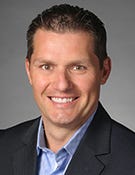How a channel expert leaned on data to get ahead.

**Editor’s Note: This is the second in a series featuring the first-ever honorees of the Channel Partners/Channel Futures Channel Influencer Awards. Read our profile of Comcast Business’ Craig Schlagbaum here.**
It’s the 1980s, and the blockbuster action movie “Top Gun” lights up the silver screen. A cocky fighter pilot with the call sign “Maverick,” astride a Ninja 900 motorcycle, races an F-14 Tomcat jet while on his way to win the heart of a blonde bombshell.
A wide-eyed, 15-year-old Canadian boy watches in wonder.

Forrester’s Jay McBain
“I was at the height of my hormones,” says Jay McBain, now a Forrester analyst. “That was going to be me rolling into high school. I had to earn $4,000 to buy the bike when I turned 16. Since I tracked every penny I made on my paper route, I knew it would take me exactly six months.”
McBain bought the motorcycle and has been running full throttle ever since. At age 27, he rose to become a national sales manager at IBM. At 37, a channel chief at Lenovo. At 40, he held the CEO post at ChannelEyes, a global software company.
His fierce ambition is matched only by an obsession with data. Since his teenage years, McBain claims to keep a daily log of every pay stub, every receipt, every report, every picture. He says he can produce a pie chart of his entire financial life.
Apparently, high-flying ambition and data as a wingman make a heck of a team.
“Data propelled me past my peers,” McBain says.
Data, You Can Be My Wingman
After graduating from the University of Lethbridge with bachelor degrees in management information systems and public administration, McBain took a job as a server technical engineer and support agent at IBM. He became a sales rep shortly after, and that’s when his budding career nearly crashed and burned.
McBain says IBM sales reps in Winnipeg, Manitoba, forged relationships with clients during National Hockey League games and at bars. Deals were often struck on paper napkins near closing time. While McBain enjoys hockey – he still plays twice a week – he doesn’t drink and couldn’t build client relationships over booze. A senior sales manager sat the young McBain down and told him that he probably wasn’t going to make it.
Instead of picking up the bottle, McBain turned to data.
He began building a spreadsheet with 100 columns, stuffing it with 500 companies in Winnipeg. He recorded key contacts and decision makers. While on vacation, he drove around town, peering into windows of companies and writing down the number and makes of desktops, laptops and servers.
“Then I did a very transactional, data-driven sales approach by going after every cell of the spreadsheet every day,” McBain says. “It wasn’t about buying beers and going to hockey games. It was about all-out …
… transactional, tactical selling. I could spend three or four hours – the length of a hockey game – getting through 10 companies.”
It worked, and IBM’s market share in the province of Manitoba rose to 72 percent — the highest, by far, of IBM’s 300 territories around the world. Top IBM executives flew from Armonk, New York, to Winnipeg, to learn about McBain’s maverick selling tactics.
By 2000, McBain, now living in Toronto, was running Canada for IBM as national manager of strategy and operations and, later, national sales manager for SMB, public sector and telesales. Again, he found a way to use data to soar to greater heights.
At the time, IBM was sorting PC sales opportunities by company size – small-to-midsize business, midmarket and enterprise — not by the 27 industries it served.
This didn’t make much sense to McBain, and so he began mapping out a knowledge-worker index. Patterns emerged. In manufacturing, 20 percent of employees used a PC. In insurance, 80 percent. In technology, close to 110 percent (many employees had more than one PC). This meant that a 1,000-employee manufacturer had roughly the same PC sales opportunity as a 100-employee tech company.
“I could actually get an entire list of every company in Canada, multiply it out by their industry – how many PCs they ought to have installed – and put it up against our wallet share,” McBain says. “I literally had a list of hundreds of thousands of companies sorted by wallet share. The companies we thought we were doing well in, we weren’t. The companies we thought we were small in, we were actually large.”
IBM stopped sorting PC sales opportunities by company size and started using the knowledge-worker index.
Highway to the Danger Zone
With data, McBain has the uncanny ability to lock in on markets. He’s taken this skill to a new job. Last summer, he became a principal analyst covering global channels at Forrester. As a researcher, he saw an unsettling scene unfolding: a dogfight in the cloud, with clear winners and losers.
Many of the losers are going to be traditional channel partners, McBain says. They face powerful headwinds because they can’t relate to line-of-business executives (LOBs) — the new shot callers in tech. A Forrester survey found that business leaders lead or influence 65 percent of software-buying decisions.
McBain says LOBs have dramatically different buying behaviors, preferring to research products on their own online. This will force tens of thousands of smaller channel partners out of business and drive further consolidation of midsize-to-large partners and distributors.
“There’s a big threat that 80 percent of the partners are going to be relegated to infrastructure and the single-digit declining business for the next 20 years, which are managed services, hardware sales, and CIO and IT department-led initiatives,” McBain says.
Meanwhile, the winners are going to be newcomers and outsiders emerging from the shadows with guns blazing, aiming to strike down traditional channel partners, McBain says.
Here are five types of what McBain calls “shadow channel” companies: SaaS consultants with deep expertise in one or two ecosystems vendors, such as Salesforce, Marketo, NetSuite and Workday; independent software vendors with products inside these ecosystems; born-in-the-cloud companies offering …
… back-end integration services; hotshot startups with hyper-targeted products; and adjacent consulting services, such as accounting firms, getting into the tech services game.
There’s a reason shadow channel companies have come to this space: high margins. This is a good sign for traditional channel companies, too, McBain says. Channel companies that can change course and court the LOBs will find a target-rich environment.
“I lived in the day of big 30-40 percent margins for PCs in the channel, and I was in charge of the programs that reduced that to two,” McBain says. “But today, I watch the margins in SaaS business applications at 40 percent. Millennials working at shadow channel companies have figured out the new buyer and how to add value, and they’re making money hand over fist.”
The channel is going to take off, he says, growing by five to 10 times over the next three to five years.
Afterburner
McBain isn’t slowing down, either.
He’ll deliver a keynote at the Channel Partners Conference and Expo in Las Vegas on April 18. He’s putting the final touches on a major Forrester report on channel marketing automation. This summer, he expects to graduate with an MBA from Louisiana State University.
Is it all hard work and no joy? Hardly.
McBain takes online courses at LSU from his new home in South Florida, where he lives with his wife, Michelle. Looking like a mansion fit for a movie star, the two-story, Spanish-style home is surrounded by palm trees. There’s a pool with a waterfall, pink flamingos, and a multi-car garage.
Inside the garage, among a few polished vehicles, is a brand-new Honda CBR650F motorcycle, because McBain still feels the need for speed.
Read more about:
AgentsAbout the Author(s)
You May Also Like


